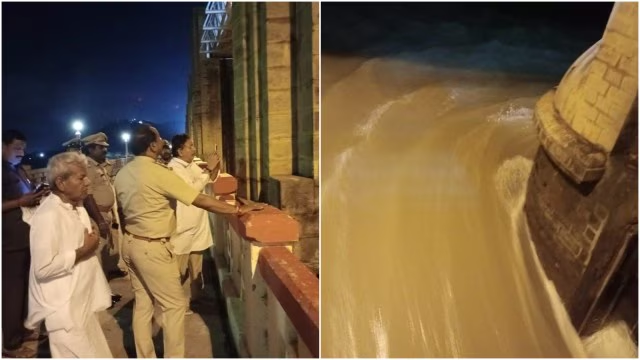The recent incident at the Tungabhadra Dam in Karnataka, where one of its crest gates was washed away, has raised significant concerns regarding flood safety and infrastructure integrity. This event, which occurred late on August 10, 2024, has drawn attention due to its rarity and potential impact on the surrounding communities and agricultural lands.
Overview of the Incident
The Tungabhadra Dam, located in the Vijayanagara district, is a vital water resource for Karnataka, Telangana, and Andhra Pradesh, serving multiple purposes such as irrigation, hydroelectric power generation, and flood control. On the night of August 10, the chain link operating Crest Gate No. 19 broke, leading to the gate being washed away by the force of the water. This incident marked the first of its kind since the dam’s completion in 1953, highlighting the vulnerability of such critical infrastructure.
As a result of the damage, the outflow from the dam surged dramatically, with the remaining 32 gates opened to manage the increased pressure. The total discharge exceeded one lakh cusecs, with approximately 35,000 cusecs flowing through the damaged gate alone. Authorities are now faced with the urgent task of managing this outflow while ensuring the safety of downstream communities.
Immediate Responses and Safety Measures
In response to the incident, the Karnataka government has alerted residents in downstream villages, particularly in Ballari and Raichur districts, advising them to remain vigilant and avoid areas near the riverbanks. The Deputy Chief Minister and Water Resources Minister, D.K Shivakumar, visited the site to assess the situation and coordinate emergency responses. Officials have emphasized that, despite the damage, there is currently no immediate threat to the dam’s safety or the surrounding areas, as the reservoir has sufficient capacity to handle the increased outflow.
To facilitate repairs, it is necessary to reduce the water level in the dam by approximately 20 feet, which will require the discharge of around 60-65 TMC of water. Experts estimate that maintaining a discharge rate of 2 lakh cusecs for the next few days will be essential to lower the water levels sufficiently for repair work to commence.
Historical Context and Infrastructure Concerns
The Tungabhadra Dam has a storied history, having been a crucial asset for regional agriculture and water management since its construction. However, over the years, issues such as silt accumulation have affected its operational efficiency. Recent maintenance efforts in May 2024 included thorough inspections and repairs, leading officials to believe the gates were in good working order before the incident. This has raised questions about the long-term management and oversight of the dam’s infrastructure, with some critics suggesting that recommendations from the Dam Management Committee have not been adequately addressed by the state government.
Future Implications and Recommendations
The incident at the Tungabhadra Dam serves as a critical reminder of the importance of regular maintenance and proactive management of water infrastructure. As repair efforts begin, the state needs to prioritize the safety of residents in flood-prone areas and ensure that the dam’s operational protocols are reviewed and updated as necessary.
Additionally, there is a growing call for the construction of a balancing reservoir to mitigate the impacts of silt accumulations and enhance the dam’s capacity to manage water flow effectively. Such measures could help prevent similar incidents in the future and ensure the continued reliability of this vital resource.
Conclusion
The washing away of a crest gate at the Tunghabhadra Dam has prompted immediate action from authorities and raised awareness about the potential risks associated with aging infrastructure. While the situation is currently under control, ongoing monitoring, and proactive measures will be crucial in safeguarding the communities that rely on the dam for their water supply and agricultural needs. As repair work commences, the focus must remain on ensuring the safety and well-being of the residents downstream, while also addressing the long-term management of this critical asset.










